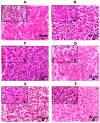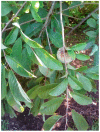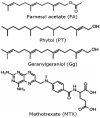In Vivo, In Vitro and In Silico Anticancer Activity of Ilama Leaves: An Edible and Medicinal Plant in Mexico
- PMID: 38731446
- PMCID: PMC11085222
- DOI: 10.3390/molecules29091956
In Vivo, In Vitro and In Silico Anticancer Activity of Ilama Leaves: An Edible and Medicinal Plant in Mexico
Abstract
Ilama leaves are an important source of secondary metabolites with promising anticancer properties. Cancer is a disease that affects a great number of people worldwide. This work aimed to investigate the in vivo, in vitro and in silico anticancer properties of three acyclic terpenoids (geranylgeraniol, phytol and farnesyl acetate) isolated from petroleum ether extract of ilama leaves. Their cytotoxic activity against U-937 cells was assessed using flow cytometry to determine the type of cell death and production of reactive oxygen species (ROS). Also, a morphological analysis of the lymph nodes and a molecular docking study using three proteins related with cancer as targets, namely, Bcl-2, Mcl-1 and VEGFR-2, were performed. The flow cytometry and histomorphological analysis revealed that geranylgeraniol, phytol and farnesyl acetate induced the death of U-937 cells by late apoptosis and necrosis. Geranylgeraniol and phytol induced a significant increase in ROS production. The molecular docking studies showed that geranylgeraniol had more affinity for Bcl-2 and VEGFR-2. In the case of farnesyl acetate, it showed the best affinity for Mcl-1. This study provides information that supports the anticancer potential of geranylgeraniol, phytol and farnesyl acetate as compounds for the treatment of cancer, particularly with the potential to treat non-Hodgkin's lymphoma.
Keywords: Annona macroprophyllata; acyclic terpenoids; agri-food waste; cancer; docking; flow cytometry; ilama leaves; morphological analysis.
Conflict of interest statement
The authors declare no conflicts of interest.
Figures









Similar articles
-
Caryophyllene Oxide, a Bicyclic Terpenoid Isolated from Annona macroprophyllata with Antitumor Activity: In Vivo, In Vitro, and In Silico Studies.Int J Mol Sci. 2024 Dec 12;25(24):13355. doi: 10.3390/ijms252413355. Int J Mol Sci. 2024. PMID: 39769118 Free PMC article.
-
Understanding the Antilymphoma Activity of Annona macroprophyllata Donn and Its Acyclic Terpenoids: In Vivo, In Vitro, and In Silico Studies.Molecules. 2022 Oct 21;27(20):7123. doi: 10.3390/molecules27207123. Molecules. 2022. PMID: 36296714 Free PMC article.
-
Molecular docking studies of bioactive compounds from Annona muricata Linn as potential inhibitors for Bcl-2, Bcl-w and Mcl-1 antiapoptotic proteins.Apoptosis. 2018 Jan;23(1):27-40. doi: 10.1007/s10495-017-1434-7. Apoptosis. 2018. PMID: 29204721
-
Annona muricata leaves induce G₁ cell cycle arrest and apoptosis through mitochondria-mediated pathway in human HCT-116 and HT-29 colon cancer cells.J Ethnopharmacol. 2014 Oct 28;156:277-89. doi: 10.1016/j.jep.2014.08.011. Epub 2014 Sep 4. J Ethnopharmacol. 2014. PMID: 25195082
-
Antigrowth activity and induction of apoptosis in human melanoma cells by Drymis winteri forst extract and its active components.Chem Biol Interact. 2019 May 25;305:79-85. doi: 10.1016/j.cbi.2019.03.029. Epub 2019 Mar 29. Chem Biol Interact. 2019. PMID: 30935903
Cited by
-
Anti-lymphoma Activity of Acyclic Terpenoids and Its Structure-Activity Relationship: In Vivo, In Vitro, and In Silico Studies.Int J Mol Sci. 2025 Jun 13;26(12):5683. doi: 10.3390/ijms26125683. Int J Mol Sci. 2025. PMID: 40565145 Free PMC article.
-
Antiprotozoal Activity Against Entamoeba hystolitica and Giardia lamblia of Cyclopeptides Isolated from Annona diversifolia Saff.Molecules. 2024 Nov 28;29(23):5636. doi: 10.3390/molecules29235636. Molecules. 2024. PMID: 39683795 Free PMC article.
-
Caryophyllene Oxide, a Bicyclic Terpenoid Isolated from Annona macroprophyllata with Antitumor Activity: In Vivo, In Vitro, and In Silico Studies.Int J Mol Sci. 2024 Dec 12;25(24):13355. doi: 10.3390/ijms252413355. Int J Mol Sci. 2024. PMID: 39769118 Free PMC article.
References
-
- Julián-Loaeza A.P., Santos-Sánchez N.F., Valadez-Blanco R., Sánchez-Guzman B.S., Salas-Coronado R. Chemical composition, color, and antioxidant activity of three varieties of Annona diversifolia Safford fruits. Ind. Crops Prod. 2011;34:1262–1268. doi: 10.1016/j.indcrop.2010.06.012. - DOI
-
- Otero-Sánchez M.A., Becerril-Román A.E., Castillo-Morales A., Michel-Aceves A.C., Ariza-Flores R., Barrios-Ayala A., Rebolledo-Martínez A. Producción de ilama (Annona diversifolia Saff.) en el trópico seco de Guerrero, México. Rev. Chapingo Ser. Hortic. 2006;12:137–146. doi: 10.5154/r.rchsh.2005.09.035. - DOI
-
- Lefebvre C., Segura S., Carmona A., Mathuriau C., Barrios S., Andrés J., Medellín-Azuara J. Linking local Appreciation with conservation of an edible fruit species: The case study of Ilama (Annona diversifolia Saff.) in Tierra Caliente, Mexico. Nat. Resour. 2018;9:337–353. doi: 10.4236/nr.2018.910021. - DOI
MeSH terms
Substances
LinkOut - more resources
Full Text Sources

